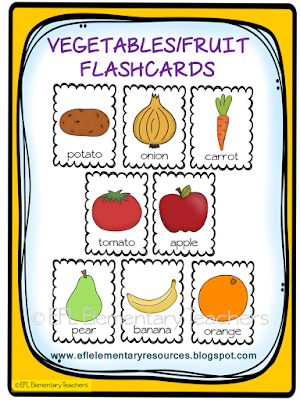Here are resources and activities for the Clothes Theme.
Link to the resources:
Link to the resources:
How many? Give each group of student clothes small
flashcards in different colors and have them sort all the pieces.
Teacher: How many
dresses ?
Students: six. Six
dresses.
Then ask them to sort
the clothes by color.
Teacher: How many
red ?
Students: four.
Teacher: Which
color has more clothes ?
Students: green
and blue.
Teacher: Which
color has less clothes ?
Students: white
and black.
Then ask them to make
patterns.
Teacher: green
shoe, brown shoe, green sock, brown sock.
Teacher: red cap,
red dress, pink cap, pink dress.
Alphabet. Review the
alphabet by having the students say the starting letter for each clothing item.
Teacher: letter B!
Students: B is for blouse. B is for boots.
Continue with all the other letters. Students can write all
the letters and make a chart as in the example.
Sort by season.
Talk to the students that there´s appropriate clothes for each weather. Have them sort all the cutouts. Then, write
each season and all the clothes that are worn on each one.
Sort by family
members. Also have the students tell
you the clothes that each family member wears. Also discuss which can be used
by the same family members, make a Venn Diagram.
Teacher: Look at the dress. Whose
dress is it ?
Students: It´s Mommy´s dress.
Sort by gender.
Sort by Singular and Plural. It is and They are.
Teacher: What are these?
Students: They are pants!
Teacher: What color are the pants?
Students: They are blue.
Teacher: What is this ?
Students: A dress.
Teacher: What color is the dress ?
Students: green.
Teacher: She is wearing a green dress.
Continue with the rest of the clothes.
Teacher: Is she wearing pants?
Students: No, she isn´t.
Teacher: Is wearing brown sandals?
Students: Yes, she is.
Hand in flashcards to all the students and have them write a
text relate to what the person is wearing.
He is wearing a
black jacket, a red and blue t-shirt, blue jeans, brown belt and brown shoes.
 Hand in another flashcard and have the students write
questions that can be answer in a yes or no form.
Hand in another flashcard and have the students write
questions that can be answer in a yes or no form.
Is she wearing a
blouse ?
Is she wearing a
pink dress ?
Are her shoes
purple ?
Is she wearing a
hat or a scarf on her head ?
 Describing clothes using adjectives.
Draw a t-shirt on the board. Draw some stripes with colored chalk or markers.
Then write stripped. Continue with dots, floral, zebra, leopard, army, plaid
and many more. Use the clothes flashcards to show the printed clothes. Ask
questions.
Describing clothes using adjectives.
Draw a t-shirt on the board. Draw some stripes with colored chalk or markers.
Then write stripped. Continue with dots, floral, zebra, leopard, army, plaid
and many more. Use the clothes flashcards to show the printed clothes. Ask
questions.
Teacher: What pattern does his pants have ?
Students: His pants are camouflage.
Sort the flashcards using adjectives. Here are some examples.
Teacher: Who has a dress ? (
all the students that have a flashcard with a dress will stand up.)
Teacher: Who has a pink dress ? (
all the students that have a flashcard with a pink dress will continue standing
up and the others will sit down.)
Display several flashcards on the board. Give them an
allotted time to write sentences related to each one. Ask a student to read their sentences, all
the other students that have the exact same one, should tick the sentence. Ask
more students to read their sentences. The student with more sentences ticked
is the winner.
Use the flashcards to label the clothes. You can place them in a cover sheet and have the students use white board markers, or place them on the board and have the students label them.
I have a fashion catalog for free at my store:
But I made a new and better version. It´s just a cut and paste from magazines and students can be able to write a short description for each.
And prepositions are always used related to clothes. I got four furniture clip art and several clothes cutouts.
Teacher: Who´s this ?
Students: It´s Daddy.
Teacher: This is Daddy´s closet. Look what is in Daddy´s closet.
Students: pants, sweater and a belt.
Teacher: There are pants, a sweater and a belt in Daddy´s closet.
More to this resource at this link: https://eflelementaryresources.blogspot.com/2018/08/more-clothes-theme-resources-and-ideas.html
Please follow my store.LINK:








































